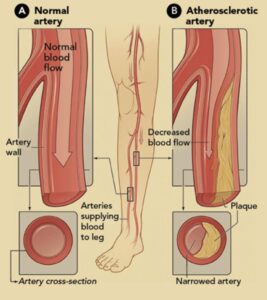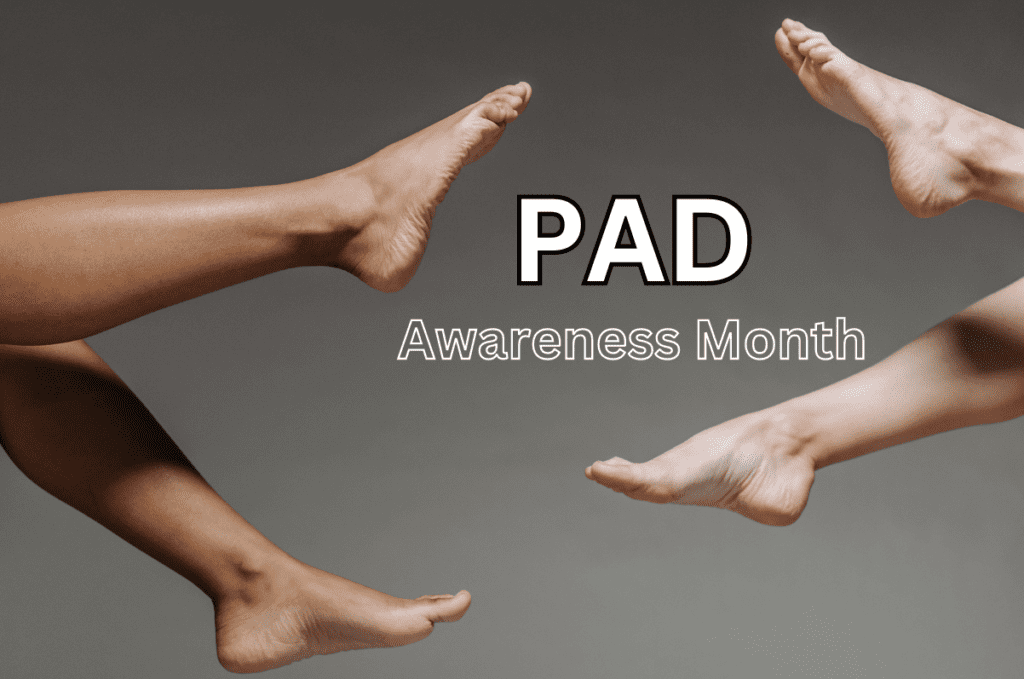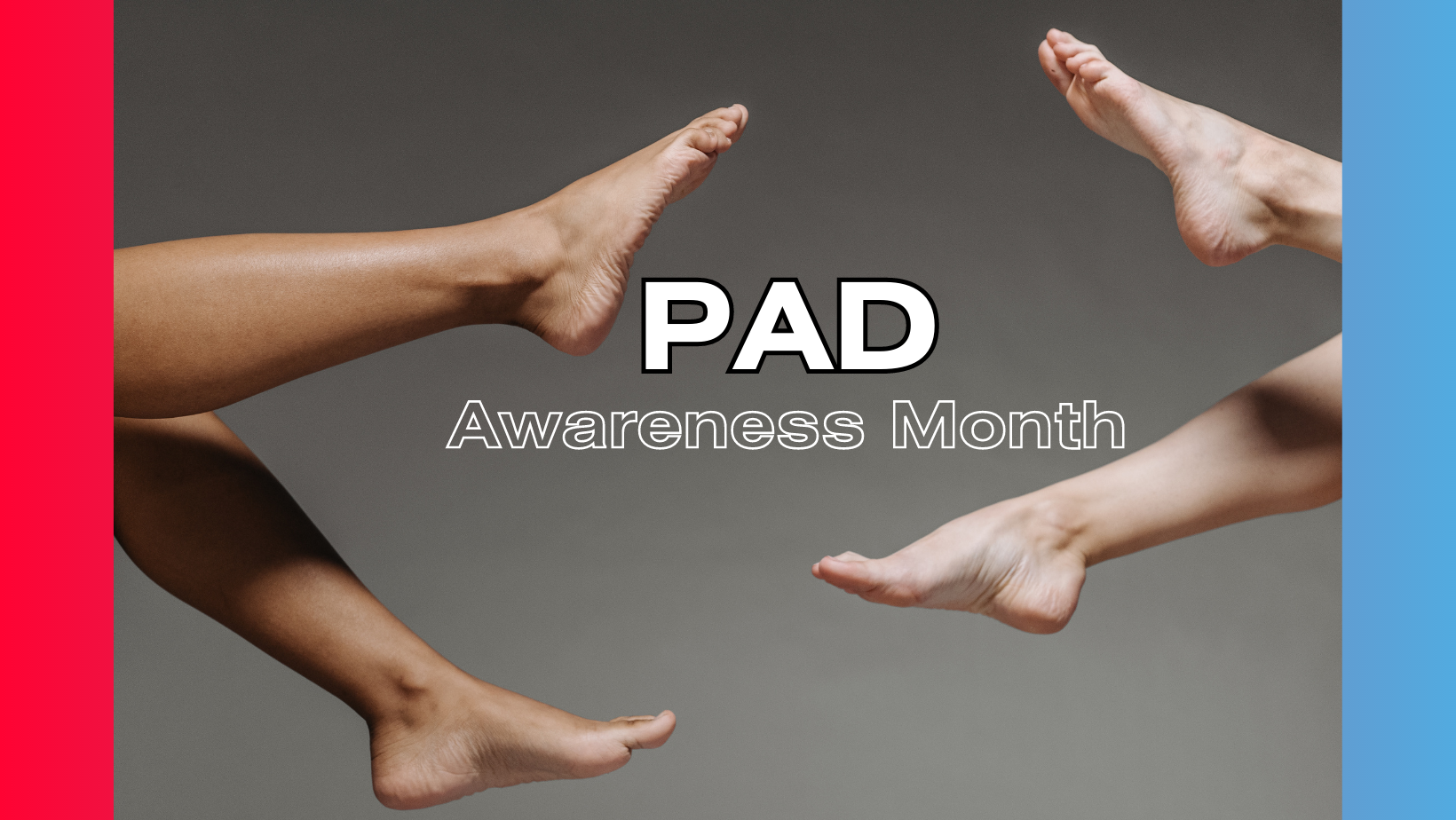September is Peripheral Artery Disease or P.A.D. awareness month. A time for us to raise awareness about this chronic circulatory condition. PAD is a common, yet serious, disease. PAD is treatable, but left untreated can lead to heart attack, stroke, loss of limb, or even death. According to the National Institutes of Health, P.A.D. affects 8 – 12 million people in the United States. Yet, it is a condition that people are widely unfamiliar with and often goes undiagnosed.
What is PAD?

P.A.D. stands for Peripheral Artery Disease.
Peripheral Artery Disease often affects the lower extremities limiting blood flow to the legs and feet.
PAD is commonly caused by atherosclerosis, sometimes called “hardening of the arteries”. Atherosclerosis is a thickening or hardening of the arteries caused by a build-up of fatty plaque in the inner lining of an artery.
Though lower-extremity PAD is the most common, atherosclerosis can narrow and block arteries throughout your body, including in the heart, kidneys, brain, arms, and pelvis. Left untreated PAD can increase your risk of coronary artery disease, heart attack, and stroke.
Symptoms of PAD
Painful cramping of muscles in your buttocks, thighs, or calves occurs during activities such as walking, climbing stairs, or exercising.
Many patients don’t report this pain to their family doctor because the pain goes away once they stop moving, they don’t think it’s a big deal, or they think it’s just a natural part of aging.
Other symptoms of Peripheral Artery Disease to keep a look out for include:
- Pain in the legs or feet that does not go away when you stop exercising.
- Pain in the legs or feet that disturbs your sleep.
- Color changes in the skin of your feet.
- Wounds or sores on your legs, feet, or toes that heal slowly or not at all.
- A notable decrease in the temperature of your lower leg or foot (compared to the rest of your body).
- Decreased hair growth on your legs or poor toenail growth.
Many people with PAD do not notice any symptoms. If you believe you may be at risk for PAD talk to your family physician.
Who is at risk for PAD?
PAD is common as people grow older. According to the American Heart Association, it affects about 8.5 million American adults over the age of 40. Risk factors for PAD include:
- Smoking
- High Cholesterol
- Type 2 Diabetes
- High Blood Pressure
- Physical Inactivity
- Family Medical History
- Age above 60 years
What Can I Do to Decrease my Risk of Peripheral Artery Disease?
Some risk factors for PAD can’t be controlled such as a family history of PAD or your age.
But there are some things you can do to reduce your risk of PAD:
- If you smoke Quit – Smoking is the top risk factor for PAD.
- If you have Type 2 Diabetes, manage your blood sugar levels.
- Eat healthy and exercise regularly.
- Maintain a healthy weight
- Make regular appointments with your family doctor and ask your doctor to examine your feet.
- Take medications as prescribed such as cholesterol medications or antiplatelet medicines.
How is PAD Diagnosed?
Your family doctor can diagnose and treat PAD. If you’re concerned about PAD, the first step is to talk to your primary care provider.
Your primary care physician can review your family medical history with you, perform a physical exam, and conduct diagnostic tests.
Information About You
During a review of your medical history, your doctor will likely go over information such as:
- Your history of diabetes, high blood pressure, high cholesterol.
- Your family medical history of Peripheral Artery Disease or heart disease.
- Any symptoms you may be experiencing such as leg pain during exercise.
- Your current lifestyle including your smoking status, diet, and exercise habits.
Physical Exam
During a physical exam, your family doctor may look for signs of PAD by:
- Checking your feet and legs for signs of wounds that are not healing.
- Checking the color, temperature, and appearance of your legs and feet.
- Performing a simple ABI (ankle-brachial index) test.
An ABI or ankle-brachial index test is a painless and non-invasive test that compares the blood pressure in your lower legs to the pressure in your arm.

Other Diagnostic Tests for PAD
If your doctor determines that your ankle-brachial index or ABI test results are abnormal, other diagnostic tests may be recommended:
- MRA – Magnetic resonance angiography
- Duplex Ultrasound
- CT angiography
- Peripheral angiogram
What is the Treatment for Peripheral Artery Disease?
Pad treatment often involves lifestyle changes, medications, or a combination. These lifestyle changes may include: quitting smoking, increasing activity or exercise, controlling high blood pressure and high cholesterol, managing type 2 diabetes, eating a heart-healthy low-fat diet, and maintaining a healthy weight.
Medications prescribed to treat PAD can include antiplatelet medicines, high blood pressure pills, and or cholesterol-lowering medicine. If medication and lifestyle changes aren’t enough, some patients with peripheral artery disease may need a minimally invasive surgical procedure such as angioplasty, stent placement, peripheral atherectomy, or clot removal.
Peripheral Artery Disease, or PAD, usually affects the lower extremities by limiting blood flow to the legs and feet. It is a common, yet often undiagnosed, disease. Left untreated can lead to heart attack, stroke, limb amputation, or death. The good news is that PAD is very treatable.
If you have concerns about your risk of PAD and would like to speak with one of our caring medical professionals, contact our West Sacramento or Greenhaven family practice office for an appointment. Your River Bend Medical Associates family doctor can address your concerns about PAD, perform a physical exam, and determine if further testing is needed. As part of your medical team, we are here to provide you with the best care in all aspects of your healthcare needs. For more information on our family medical practice, or to make an appointment, contact River Bend Medical Associates, or call 916-392-4000.


